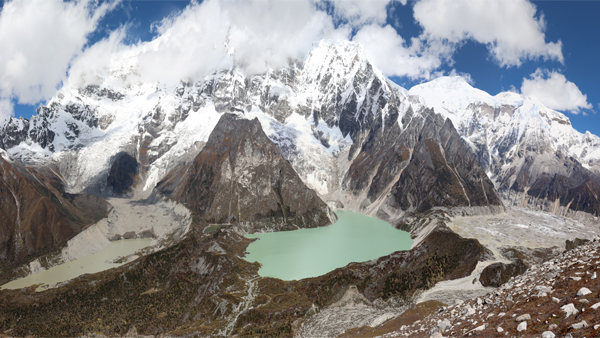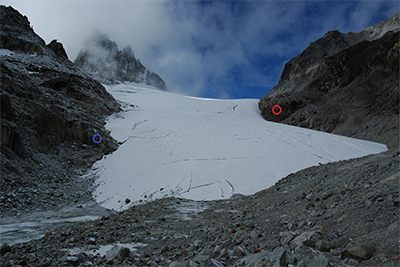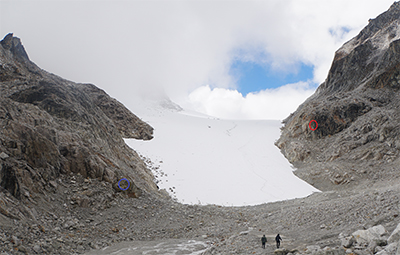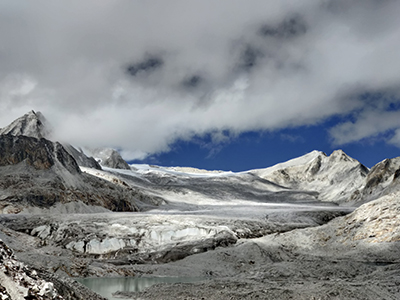
The world is witnessing erratic weather patterns with the sea level rising at an alarming speed triggered by the glaciers melting at a pace many researchers did not expect for decades. And here in the country, 700 glaciers have retreated rapidly that the country in 50 years may see ice-free lakes and this according to experts is largely fueled by climate change.
Rising temperature as a result of climate change is accelerating the rate of glacier melt in Bhutan.
With the consistent rise in temperature from April to June last year, one of the Thorthormi subsidiary lakes breached due to glacier surge caused by melting of ice. A glacial lake outburst flood (GLOF) occurred then, caused fresh slides on Moraine dam between Raphstreng lake and Thorthormi.
39-year-old Phuntsho Tshering, working with the National Centre for Hydrology and Meteorology (NCHM) as a geologist has been to Thorthormi last month, for the 13th time. As arduous as it is to travel to Lunana on foot for 10 days, it is important for his team to study the dam to assess the hazard.
“We went to Thorthormi this time to mainly reassess the moraine dam. There are no significant changes compared to last year but there are still some slides. There is main ice just above Thorthormi, though we couldn’t go physically inside and measure, but when we look from outside, there isn’t much disturbance,” said Phuntsho.
However, the team of experts say, without equipment to study the huge ice block in the moraine dam between Raphstreng lake and Thorthormi, the status of the ice below the dam is unknown. And if the ice block melts, the dam will be breached, releasing 53 million cubic meters of water down the water bodies causing a”Tsunami” as they call it.
“Researchers have said in the past that if the dam is breached, Thorthormi could overtop Raphstreng and cause GLOF. And we focus on this barrier,” he added.
What’s more alarming is the rate at which the two benchmarked glaciers, Gangju La Glacier and Thana Glacier are retreating or losing its mass.

The centre has been monitoring the Gangju La Glacier, located at the Pho Chhu sub basin since 2004. The glacier since then has retreated on an average of 11.4 metres per year. With annual glacier mass balance and total cumulative loss in negative, meaning the glacier loss is more than the glacier formed, the experts say the glacier is not in a healthy state. The glaciers in the last 16 years have lost 5000 tonnes of water.
“For 11 years until 2011, we couldn’t monitor. We again collaborated with Japanese experts and started monitoring the glacier. Since 2011, we have been going there and studying the impact of climate change on the benchmarked glacier and all these years, we have recorded that ice is melting more than it is formed,” he said.

In 2019, the maximum thickness of the Gangju La glacier was recorded at 96.44 metres.
Similar is the case with Thana Glacier, located above Chamkhar Chu. The Thana glacier is retreating at an average retreating rate of 18.2 metres per year. According to NCHM, the glacier has lost a total area of 1.49km2 from 1980 till last year and the glacier is losing 5.98 metres water equivalent per m2. The maximum thickness of Thana glacier was recorded in 2018 with 228.86 metres.

“Glaciologists across the world and climate change experts say that the temperature is in a rising trend and if the temperature continues to rise or if it remains as it is, the Himalayan glaciers are going to retreat. We haven’t researched when, but we are sure that one day, these glaciers would become small and we can’t even study them. We have benchmarked two but all other lakes are retreating at the same pace.”
The rivers in Bhutan are fed by the glaciers in the country’s north and it has been the source of life for centuries. But if glaciers melt and keep on losing water at the current pace, experts say water downstream are likely to get less or even dry up in years to come.
“Our perennial water that flows continuously even in winter, all comes from such sources. When actually the glacier is melting, we have plenty of water but after the glacier’s size is reduced to optimum, it can affect our water resources because it melts less and its contribution to river tributaries become minimal,” he added.
Having studied the glacier lakes and the impact of temperature on the stability of these lakes, NCHM has been installing the early-warning system throughout the lake and river system. The system with a siren gives the people living downstream a chance to act before a flood hits.
“One of the ways to adapt to this kind of hazard and risk is to increase the coping capacity of the community. In this early warning system for the GLOF, we have monitoring stations monitoring the lake itself and the outlets of the lake and then we have the warning sirens placed along with the vulnerable communities. So for example, if there is something happening up there in the lake, the system automatically triggers the warning siren in the community where people can evacuate,” said Sangay Tenzin, the Project Engineer with the NCHM.
But the maintenances and repair of the early warning system have become a challenge.
“When we first installed the technology in 2008, we used to say that it is the state of the Art technology but now as we realise, the system has been running for ten years. It’s already a time for us to add on or upgrade the equipment, those things are due with us. We are still looking for some kind of funding for this,” he added.
The sensor in the early warning system according to NCHM also helps to keep the tap of changing temperatures, letting officials know the cause of GLOF or melting glaciers.
Bhutan witnessed the worst GLOF in 1994 and there was no warning for the villagers living along Punatshangchhu. The flood killed 21 people, damaged agricultural land, and destroyed houses.
And in the present scenario, more at risk due to melting glaciers is the country’s biggest revenue generator, the Hydropower sector. Whether the GLOF happens or the glacier disappears, the sector is likely to bear the brunt.
As climate changes and temperature rises, the glacier in the mountains is a hazard that could unleash anytime.
Sangay Chezom









